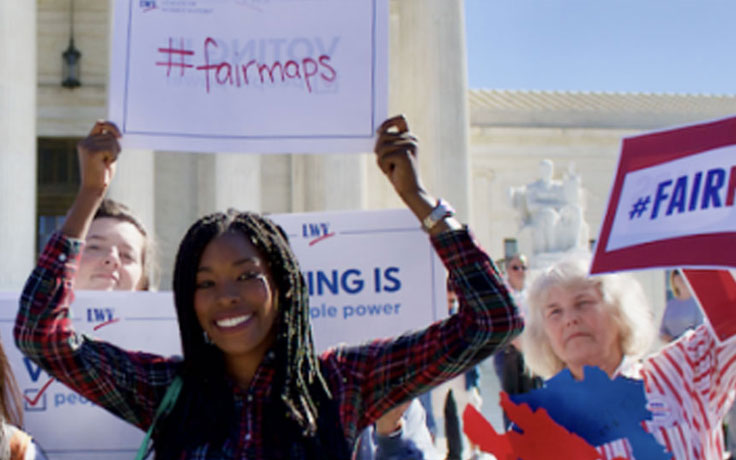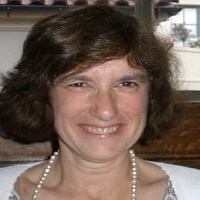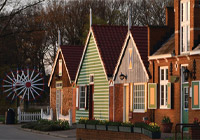STEPHANIE GOMEZ WAS 19 WHEN, as she tells it, “I was discovered by the League of Women Voters.”
A rising sophomore at Mount St. Mary’s University, she was staffing an American Lung Association table at a 2016 voter-education forum sponsored by the Los Angeles branch of the League. On the state ballot was a $2-a-pack cigarette tax (which passed). Crissi Avila, co-president of the L.A. League, dropped by and introduced herself. “She invited me to the League’s annual meeting.”
Gomez, a Latinx woman, was interested in politics but nervous about attending. She went anyway and liked what she found. She joined and has become an evangelist for the League, whose members have long been typically much older and White. At 23, Gomez sits on its L.A. board of directors, chairs its L.A. nominating committee and has started a chapter at her alma mater. A first-generation college graduate whose wide smile colors her voice, she credits the League with teaching her leadership skills and “how people can work together.”
“I see myself staying in the League indefinitely,” she said. “I rave about it.”
A century after its founding, the survival of the League of Women Voters as a relevant, thriving community depends upon change, especially during this time of partisan division, the COVID-19 pandemic and angry protests against racism. The League is evolving from a mostly White organization founded to encourage women to exercise their newly won suffrage into a more ethnically diverse assembly that attracts young men as well as young women — like Stephanie Gomez, with her energy and enthusiasm.
Its future may hang equally on whether the League’s values — nonpartisan civic education, respectful debate and encouraging every citizen to vote — still resonate in these highly partisan times.
The League’s mission statement — “Empowering Voters. Defending Democracy.” — is no radical manifesto. But escalating efforts to suppress voter turnout by purging registration rolls and imposing identification requirements, together with moves by President Trump and his Republican allies to sharply limit mail-in balloting, are hammering the League with new challenges to its bedrock belief that all citizens should be able to vote.
In contrast to the sugar rush of policymaking by tweet, League volunteers persevere in the face of such challenges, still shouldering the slow, unheralded but increasingly important work of studying policy options and building consensus so vital to a healthy democracy.
A century of protest
THE LEAGUE OF WOMEN VOTERS was founded months before passage of the 19th Amendment in 1920 to help women exercise their new rights as voters. Photos from early League events show members in stylish fur-collared coats and cloche hats with pearls around their necks. These members helped cement the narrative of suffrage being the work of middle- and upper-class White women, a storyline that has long dogged the group.
In truth, the path to ratification of the 19th Amendment “was complicated, and sometimes ugly,” Virginia Kase, chief executive officer of the League, wrote last year in an op-ed in The Hill. African American and Native women were an essential part of the effort, but suffrage leaders, including League founder Carrie Chapman Catt, helped win Southern support by agreeing not to challenge Jim Crow racism, allaying fears that Black voters might outnumber White voters.
As a result, “the League has had its own internal problems advocating for civil rights and the inclusion of women of color in its ranks,” said Delores Johnson Hurt, president of the Charlotte/Mecklenburg, North Carolina, League, only the second African American to head that chapter.
Early League meetings were safe places for women eager to learn about their new rights — sometimes despite their husbands’ opposition. During those first decades, the League quickly established its reputation for fairness, careful research on issues and candidates, and for promoting old-fashioned values like restrained but serious debate and discussion.
Those principles remain central League tenets, noted Raphael Sonenshein, executive director of the Pat Brown Institute for Public Affairs at Cal State L.A. “They can’t deliver voters, they can’t deliver endorsements, they can’t deliver money. What they can deliver is moral authority.”
Membership peaked in the 1960s as women, many with college educations, sought avenues for civic involvement. “They were also just tired of talking to children all day and happy to get out of the house,” said Raquel Beltrán, former executive director of the L.A. League, who now directs the city Department of Neighborhood Empowerment. Former Los Angeles Councilwoman Joy Picus credited the League with teaching her leadership skills, Beltrán, said, and with giving Picus the confidence to seek elected office.
However, as more women entered the workforce, beginning in the 1970s, membership began a slow slide to a low point in the 1990s.
A charter change in 1973 welcomed men. The League does not keep data on the race, ethnicity or gender of members, but its leaders attribute an increase in younger members, like Stephanie Gomez, to a recent diversity initiative. “Strides have been made,” said Helen Hutchison, past president of the California League, “but we still don’t represent the population as a whole.”
League membership also tends be cyclical, rising in advance of presidential elections and falling afterward. However, membership in state and local chapters has leaped by 33% since Trump’s election, climbing in cities as well as in rural and suburban chapters — and in college and high school chapters. League chapters now count a total of 500,000 members and “supporters,” who include donors and occasional volunteers.
Teaching civics
OLD-FASHIONED CIVICS education and voter information, updated to the digital age, have remained the League’s bread-and-butter for a century. Behind this continued activity is a fervent, now almost quaint, faith in the power of working together to solve common problems. “I can patch the pothole in front of my house,” Hutchison said. “But doesn’t it make more sense to join with my neighbors in asking the city to resurface the whole street?”
To that end, volunteers from the League’s 750 chapters speak regularly to community groups and corporations about the basics of how government works. They register new voters at high schools and community colleges; they explain the voting process and how voters should make decisions. And as elections approach, the League publishes candidate profiles and exhaustive pro and con arguments for pending ballot measures.
The League’s Vote411.org website, launched in 2006, is another tool for voters, a “one-stop-shop” in every state for factual information on registration, absentee ballots and polling places, as well as candidates. California voters can also access VotersEdge.org, a nonpartisan online guide to federal, state and local races. It is a joint project of the League and Maplight, a nonpartisan nonprofit that tracks money’s influence on politics.
Fairness and nonpartisanship are the League’s civic religion. The group sponsored nationally televised presidential debates in 1976, 1980 and 1984. But tellingly, the League withdrew its imprimatur when candidates began demanding what it considered partisan debate conditions. Local chapters have run debates with candidates for U.S. Senate, L.A. mayor, County Board of Supervisors and L.A. neighborhood councils.
In 2015, the L.A. League helped organize a discussion of a proposed extension of the 710 Freeway, long a contentious issue. It drew more than 200 residents. Sonenshein, whose Pat Brown Institute co-sponsored the event, worried that the discussion would degenerate into a shouting match — or worse. He credits League members stationed around the auditorium with keeping tempers in check. “Everyone underestimates the League,” he said, but “when they do an event, they have a certain level of trust that doesn’t fit the image of being irrelevant.”
Issue advocacy has become another League hallmark. Since the 1950s, the group has taken formal positions on major hot-button issues like gun violence, reproductive rights and the Affordable Care Act. The positions generally skew progressive, adopted after sometimes years of research and deliberation. State and local chapters may also weigh in on state and local ballot measures.
Proposition 15, the Schools and Communities First measure on California’s November ballot, is a current priority. The measure would amend Proposition 13, which voters passed in 1978, by taxing most commercial and industrial properties at market rate, based on regular reassessments. The estimated $12 billion a year in additional property tax revenue would help fund schools and local government services such as libraries, road maintenance and public health services, all of which have been increasingly strapped.
The League’s support for Proposition 15 is grounded in years of study by volunteers on state and local finance, followed by discussions in chapters up and down the state. However, some see an inconsistency. Bob Stern, a League member and former president of the Center for Governmental Studies, a policy research group, calls the League a “truly nonpartisan place to go for facts. … But at the same time, the League is taking positions. How can they be nonpartisan and take positions? I’m not sure they can say they’re both.”
“Well, I totally dispute that,” countered Chris Carson, a former national president of the League. “The League was founded by women who did militant advocacy. We’ve held our positions for decades,” and until recently, she said, those positions “were gosh-gee, ho-hum. Suddenly they’re partisan.
“No, they’re not.”
Nonpartisans in an era of division
AS THE NATION NEARS a climax in partisanship — the November election — it faces profound challenges to election integrity, including foreign interference, disinformation, the new hurdles to voting and problems with vote counting.
In response, the League is doubling down on its already prodigious voter education activities. And it is not shy about pressing its concerns in court. As of June 30, the League was a plaintiff or an amicus party in at least 15 cases involving mail-in balloting, several generated by the risk of coronavirus infection that in-person voting rules pose in many states.
“It’s not their model to litigate their issues, but when they can’t do their work and voting is being unfairly restricted, it seems like they take action,” said Anne Houghtaling, deputy director of the Thurgood Marshall Institute at the NAACP Legal Defense and Education Fund. The ACLU and the Brennan Center for Justice, along with the NAACP, often partner with the League on these cases.
Many of these lawsuits target Southern states where “who votes and how we vote have always been politicized,” said Delores Johnson Hurt, the Charlotte/Mecklenburg League president. The Supreme Court’s 2013 decision invalidating a key provision of the 1964 Voting Rights Act, she said, has only drawn more attention to current voter suppression efforts and their effects.
In the midst of these issues, building membership and edging away from the League’s volunteer-based model remain urgent concerns.
Unlike the Sierra Club or AARP, “the League was built on the unpaid labor of women,” said Helen Hutchison, the California League past president. The state League, with six paid staff members, is unusual; in most chapters, volunteers do everything from educating voters to fixing copying machines. “We have to change the [national] model,” Hutchison said, which means more fundraising to hire more staff.
At the same time, increasing membership means improving diversity. The League’s ongoing partnerships with the YMCA, NAACP and other groups to co-host programs or pursue litigation have helped. “You build a relationship,” Chris Carson said, “and then people join.” Carson’s successor, Deborah Turner, is the second African American to head the league nationally.
Diversity is “not just the catchphrase of the moment,” Turner said, in her inaugural address to the League’s 100th convention Zoom audience. “Without it, we will at best move sideways and, at worst, take a step back.”
IN ITS FIRST half century, the League of Women Voters focused on educating women about suffrage. Entering its second century, the League now sees participatory citizenship as the ongoing duty of all Americans, men and women, young and old — a duty that doesn’t end with marking a ballot.
In these fractious times, League volunteers are betting that their steady, quiet focus on the nuts and bolts of democracy is more valuable than ever. The League is “a hardy perennial,” said Sonenshein. “It’s never out of fashion.
“It’s never not necessary.”

























